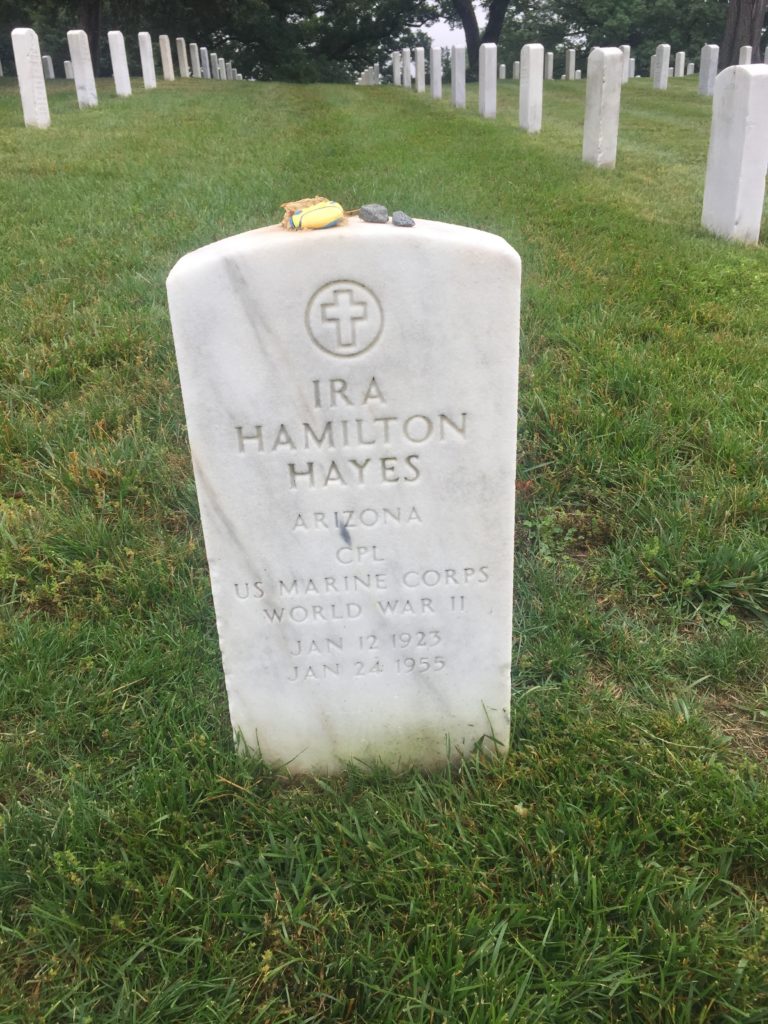Erik Visits an American Grave, Part 679
This is the grave of Ira Hayes.

Born in 1923 in Sacaton, Arizona, part of the Gila River Pima Reservation, Hayes grew up in the poverty of the Native communities who had their land stolen as Phoenix rose to become a major city. His family farmed some cotton for the market and also engaged in subsistence agriculture that itself was probably not too different than what the Pima had done in the Gila Valley for hundreds of years. He was known as a quiet, shy child who rarely spoke. He took to English very early in life, which was not necessarily real common among the Pima in the 1920s. He went to high school at the Phoenix Indian School in that city. He then served two months in the Civilian Conservation Corps in 1942, at the very end of that agency’s existence. He followed that with being a carpenter. And then he enlisted in the Marines in late 1942.
Hayes was a pretty standard Marine with a pretty standard World War II career, except for one significant moment. He was thrown into the hardest battles in the Pacific soon after he completed basic training. He was sent to New Caledonia in 1943. He was at Guadalcanal for a short time though I don’t think was involved in any serious fighting. His platoon did face heavy fire from a Japanese outfit at Bougainville in late 1943. He was then transferred back to California for a bit. He then was transferred to a new company that trained in Hawaii, getting ready for the Battle of Iwo Jima. As we all know, Iwo Jima was one of the most brutal battles of the war, with an increasingly desperate Japanese military dug into that volcano and causing enormous casualty rates on the Americans. Hayes’ platoon was responsible at the end for the cresting of Mt. Suribachi and the effective taking of the island in February 1945. Hayes made it to the top and was part of the small number of men to raise the flag on the top, which was photographed by a Marine photographer. However, the more famous photo was the recreated incident with a larger flag to make it look cooler, which I guess was effective given the fame of the photograph.
By this time, Hayes was one of only five men still left living of his platoon of 45. And three more would soon die. He was very lucky to be alive. The photographer became the 1940s version of viral. President Roosevelt ordered all the surviving members of the flag-raising operation to be brought to Washington and celebrated as war heroes. This didn’t happen until Truman had become president. All the men were big stars and they were used to sell war bonds, traveling the country to give talks and just be themselves, the war heroes who would inspire the rest of the nation to give more out of the pocketbooks to support the war effort. Hayes was promoted to corporal, was part of the occupational forces in Japan for about a month, and then discharged in December 1945.
But discharged to what? Hayes had to deal with all the memories he had seen of dead people. To say the least, the military was not set up to deal with PTSD. His Pima people were in deep poverty. He certainly didn’t have a job or career lined up for himself. He was angry that one person who had been involved in the flag raising who had later died was mislabeled. He traveled to Texas to inform the man’s parents that their son was a hero who deserved to be honored. He was still kind of a star and made an appearance in the execrable John Wayne film Sands of Iwo Jima. But he was drinking very heavily by 1948 and could not hold down a job. He was still traveling the country but mostly getting arrested for public intoxication. He even got a job as the chauffeur for Dean Martin’s ex-wife for a time, but couldn’t hold it down. About all of this, he stated his guilt: “I was sick. I guess I was about to crack up thinking about all my good buddies. They were better men than me and they’re not coming back.”
By 1955, Hayes was back on the Gila Reservation. And on January 24, 1955, he was found dead, drunk in a ditch, having just celebrated his 32nd birthday. He died of exposure and alcohol poisoning, though this was later dramatized by Peter LaFarge in his epic song “The Ballad of Ira Hayes” to have drowned in two inches of water, which wasn’t true. What did happen is that he got into a fight after a night of drinking and cards with another Pima named Henry Setoyant. Hayes’ brother blamed Setoyant for the death, but that’s probably not really the case. More likely, he just passed out in the cold.
Hayes would probably be a footnote today in our collective memory if not for LaFarge’s song and especially Johnny Cash’s definitive version.
Ira Hayes is buried on the confiscated lands of the traitor Lee, Arlington National Cemetery, Arlington, Virginia.
If you would like this series to visit other Native Americans of the twentieth century, you can donate to cover the required expenses here. Billy Frank, who led the fishing rights movement, is in Nisqually, Washington and AIM leader Dennis Banks is in Federal Dam, Minnesota. Previous posts in this series are archived here.
